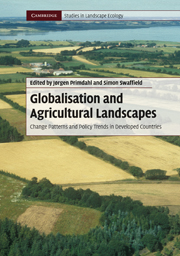Book contents
- Frontmatter
- Contents
- List of Contributors
- Preface
- 1 Globalisation and the sustainability of agricultural landscapes
- 2 Agricultural liberalisation, multifunctionality and the WTO: competing agendas for the future of farmed landscapes
- 3 Globalisation of agricultural landscapes: a land systems approach
- 4 Agricultural landscape changes through globalisation and biodiversity effects
- 5 Swiss agricultural policy reform: landscape changes in consequence of national agricultural policy and international competition pressure
- 6 Local landscape consequences of macro-scale policy reform: the New Zealand experiment
- 7 Rural landscape differentiation in the face of changing demands and policies: a typology of rural areas in Portugal
- 8 Globalisation and the local agricultural landscape: current change patterns and public policy interventions
- 9 From totalitarian to democratic landscapes: the transition in Estonia
- 10 Rural landscape change as a product of US federal policy
- 11 New approaches for urban–rural areas in Dutch spatial planning
- 12 Restoring agricultural landscapes in shrinking cities: re-inventing traditional concepts in Japanese planning
- 13 Globalisation and local agricultural landscapes: patterns of change, policy dilemmas and research questions
- Index
- References
8 - Globalisation and the local agricultural landscape: current change patterns and public policy interventions
Published online by Cambridge University Press: 05 June 2012
- Frontmatter
- Contents
- List of Contributors
- Preface
- 1 Globalisation and the sustainability of agricultural landscapes
- 2 Agricultural liberalisation, multifunctionality and the WTO: competing agendas for the future of farmed landscapes
- 3 Globalisation of agricultural landscapes: a land systems approach
- 4 Agricultural landscape changes through globalisation and biodiversity effects
- 5 Swiss agricultural policy reform: landscape changes in consequence of national agricultural policy and international competition pressure
- 6 Local landscape consequences of macro-scale policy reform: the New Zealand experiment
- 7 Rural landscape differentiation in the face of changing demands and policies: a typology of rural areas in Portugal
- 8 Globalisation and the local agricultural landscape: current change patterns and public policy interventions
- 9 From totalitarian to democratic landscapes: the transition in Estonia
- 10 Rural landscape change as a product of US federal policy
- 11 New approaches for urban–rural areas in Dutch spatial planning
- 12 Restoring agricultural landscapes in shrinking cities: re-inventing traditional concepts in Japanese planning
- 13 Globalisation and local agricultural landscapes: patterns of change, policy dilemmas and research questions
- Index
- References
Summary
Introduction
The way in which a place is shaped depends partly on autonomous decisions and actions taken by local people, partly on local adaptations and responses to decisions and events from outside, and partly on outside decisions. The specific balance or constellation of such events, decisions and actions is a key to understanding the differences between places, and likewise a key to understanding differences and similarities in the way local agricultural landscapes are changing (Jones, 1988). Unfortunately this key is not a simple one, for a number of highly interrelated reasons. First of all because external driving forces are complex and increasingly affecting the local landscape. These changes in external influence happen either through overall shifts in the dynamics of globalisation (as outlined in Chapter 1), or through some of the consequences of these changes, including changes in production, increased migratory movements and urbanisation (Harvey, 1996, 2000), all of which have significant impacts on most agricultural landscapes in the developed world. These changes take place within networks organised at different scales in what Castells has termed the ‘space of flows’, which links changes in the local landscape with decisions and actions taken outside, often at great distances from the landscape in question (Castells, 2000).
A second reason for the complexity of landscape change has to do with the changing social composition of agricultural landscapes and the changing roles and importance of agriculture.
- Type
- Chapter
- Information
- Globalisation and Agricultural LandscapesChange Patterns and Policy trends in Developed Countries, pp. 149 - 168Publisher: Cambridge University PressPrint publication year: 2010
References
- 8
- Cited by



